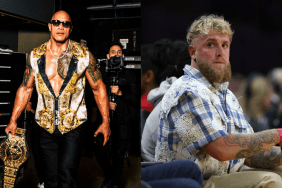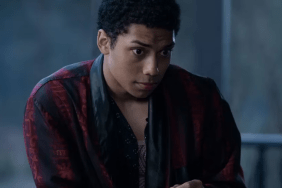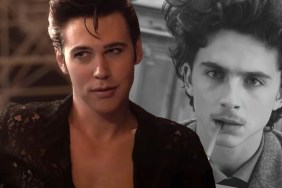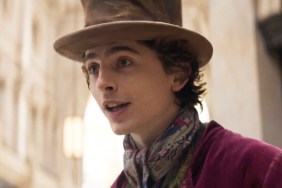Wish Upon‘s creative spark is much more than a fantastic cast and director, at its core it’s driven by an amazing production team that really worked hard to bring the film together with production design by Bob Ziembicki (Boogie Nights, Scream 2, Annabelle), costume design by Antoinette Messam (Orphan, Creed, Dirk Gently’s Holistic Detective Agency), and Paul Jones on special effects (Shadow Hunters: Mortal Instruments, Orphan Black, Ginger Snaps, Silent Hill). ComingSoon.net had the pleasure to hang out on the Toronto set earlier this year and sit down and talk with this great team, and this is what they had to say.
RELATED: Read Our Wish Upon Review
Paul Jones (Special Make-Up FX)
Jones: It’s been a nice show, I mean I love these kinds of shows. This has been one of those shows that I wish for all the time. I got to do a nice, kind of… necrotized foot, which was really, really cool, and that was kind of a nice subtle [thing] building up to a nice blackened toes kind of thing. And then we got to kill Sherilyn Fenn, and I’ve had a bit of a crush on her since Twin Peaks. Who hasn’t right? It was kind of fun to meet her, break her neck and tear a hole in her scalp.
CS: Is that an elaborate gag?
Jones: It was, yeah, we had to do a fully body reproduction of Sherilyn, so we did a head and hand cast, and the body measurements, so we did a fully articulated dummy. And the head was all silicon, the hands were silicon, and it was rigged with a cable inside so we could yank the cable through her hair, and it would just pull her head back in a completely unnatural position.
RELATED: Sherilyn Fenn Gets Scalped in Unrated Wish Upon Director’s Cut
CS: Are there a lot of practical effects in this movie?
Jones: From my point of view, yes. There’s a lot of digital stuff as well, I mean there’s a whole other practical element, which is “the box.” Which is the whole mechanical, driving force behind the movie, the actual device that kills people. That’s a full mechanical rig props built. That has moving parts and has digital elements to it.

CS: What happens to these really cool effects pieces when you’re doing filming them on set?
Jones: It really depends on the production. Sometimes they have a clause in my contract that says they own everything, so sometimes I have to give them the molds, concept designs, everything. They own the rights to everything. Sometimes I never hear from the production again and the pieces just hang on the wall of my shop forever.
CS: So can you ever re-purpose things for another production?
Jones: If it’s like an animal, then yeah. I built a dead raccoon for a TV show and it’s been in like five shows, I mean it’s a raccoon, you can’t copyright “raccoon.” But if you’re doing something like the red pyramid for Silent Hill, then you can only use that for Silent Hill.
Bob Ziembicki (Production Design)
CS: We’re looking at a house set here, how difficult is it matching what we see here to the real location?
Ziembicki: It varies. In this case it was pretty simple. Here we have lattice, and there was no lattice, but that just a nice element to use, even for just a lighting element.
CS: And now we’re looking at the attic sets?
Ziembicki: The attic, which was, from the beginning of reading the script the box was the main character, but the attic is where it all started, and schedule wise we always kind of knew we were going to build it. So whatever house to had we have to create something that had the possibility of that space. And then there was the window out in front as well, we matched that window shape from the location and planted it on the [attic wall]. So for me the attic was always symbolic. For me it was thinking inside the box, instead of outside the box, it’s inside the box in this case, everything is about the box. Location wise, set wise, I was always thinking about inside the box. The window in front of the house and in the attic is an octagon for example, and so is our box.
CS: How much of the box is a physical object they can handle on set as a prop?
Ziembicki: It is. Originally we thought of maybe doing it digitally, but one of my assistant art directors said “oh, I can carve that” and he did and John liked it very much. And there is a demonic character that John wanted to show physically rather than just mention psychologically. So it becomes a character in the center lid of the box itself.

CS: We heard the box has this mechanical element to it?
Ziembicki: We ran into the notion that it’s a real working box. So when it opens it plays the song, and then you know something bad is going to happen. And the idea was to make it into an octagon shape, the original idea was a hexagon, rather than rectangular he wanted something a little different. But octagon I thought was a little more appropriate, eight is a lucky number in Chinese culture, and the idea that there are seven wishes and the final wish after that. So we started with that shape and added pieces to fill out that shape, but knowing that it all wanted to be moving, working parts.
CS: How integral to the story is a piece like this box?
Ziembicki: Well, again it’s kind of an inspirational thing too, so it’s like physically always looking for that shape, that octagon shape, or the interior of the box. The attic was kind of my first inspiration, and then to the box, and then the rest of the movie.
CS: Is the design of the box a collaborative effort?
Ziembicki: Very much so. It started with John’s original idea. It was a Chinese box, it wasn’t a music box, but it was a Chinese box in that hexagon shape. He wanted it to be very ornate and at the same time something kind of threatening, or have something that’s a little disturbing about it as well. That’s where we started from. I own a Chinese box myself too, and I brought that in to show him and he liked that a lot. My box had bats, which as also a symbol in Chinese culture, and a little ornate mirror and he said he really liked that and our box has those similar elements.
CS: Does the box actually work?
Ziembicki: It’s mechanical; there are moving parts in it that work now. When we see the finished product a lot of that will be replaced with digital. The music box itself when you see it open, you can wind it and it works. We have two heroes, we have some rubber ones for a scene where they try and destroy it, and we have a cement one that we put in fireplace to see if it would burn. And it all started with 3D printing, digital 3D printing I had never done it before. The guy who did this, he actually does a lot of medical stuff, and that’s kind of where it all started.
Antoinette Messam (Costume Design)
CS: Tell us about how you ended up working on Wish Upon.
Messam: Wish Upon is great. I wanted to mix it up a little, my last show was something so colorful and comedic the premise with this was to take something that some people could say has been done before. I mean we’ve had the high school, the young lead and twisted little story. But I didn’t want to do a Mean Girls, I really wanted to do a youthful, or young story that looked organic or felt organic. Where kids could look at it and thing “this is my life, this is my high school.” Where they think, “I get this” and it not be formulaic, and that was really important to me.

CS: How much freedom do you have with the costume design?
Messam: Well it depends on the project you’re working on. This one it wasn’t even so much about freedom, it was about building a world. That was not so much a normal world, because you know how less and less normal worlds look normal, and I wanted this to be a chance for kids to relate. There’s not enough of that. This is not a Disney movie. I really connected with John, and I loved his passion for the project. It almost swayed me in a very short period of time.
CS: Was it a shock for you coming from something bright light Dirk Gently and moving to something like this?
Messam: No, I mean the Dirk Gently world is Max Landis’ world. I don’t know what you know about Max, but he has rainbow-colored hair fifty percent of the time you know. He really drives the creative, and part of my job was to take his world, reality, and find a relatable middle ground. With this show, it was taking what is written and building a world where you could sit back, take in the story and not be looking at the costumes. If you’re fixated on the costumes for Wish Upon, then you’re not in the story. Diversity is important to me.
CS: Can you tell me a little about the creative process for a show like this?
Messam: I was telling John this on Saturday, that the biggest honor for me as a costume designer was when he walked into my shop, and a whole wall was just a collage. It started with the cliques, and starting to just do tares and inspiration and it just kept growing and growing. And when you stepped back all the sudden I saw my movie. And he came down and said, “oh my god, there’s my movie!” But then he started bringing people down to say, “here’s the movie”!
It’s written in the script there are cliques, the populars and the skaters, and the fact that the leading lady didn’t fit anywhere. She was an artist, kind of lost and she had her friends. But to me, looking at her, the three of them, they’re like three misfits who had their own personal style, but they look normal, and that’s what was important to me. It should be subtle and not in your face, unless it’s directed in the script and then it’s a moment. That’s what John loved though, was you had these different styles, these different cliques, but you can see how they blend into one another. He [John] could see how even though they all were different, they all could exist in one school, one place.
Wish Upon
-
Wish Upon

-
Wish Upon

-
Wish Upon

WU_00871_R2Joey King stars as Claire in WISH UPON, a Broad Green Pictures release.Credit: Broad Green Pictures
-
Wish Upon

WU_01951_R(l-r.) Joey King stars as Claire, Alice Lee as Gina and Ki Hong Lee as Ryan in WISH UPON, a Broad Green Pictures release.Credit: Steve Wilkie / Broad Green Pictures
-
Wish Upon

WU_03087_RJoey King stars as Claire in WISH UPON, a Broad Green Pictures release.Credit: Steve Wilkie / Broad Green Pictures
-
Wish Upon

WU_06485_R(l-r.) Sydney Park stars as Meredith, Joey King as Claire and Shannon Purser as June in WISH UPON, a Broad Green Pictures release.Credit: Steve Wilkie / Broad Green Pictures









